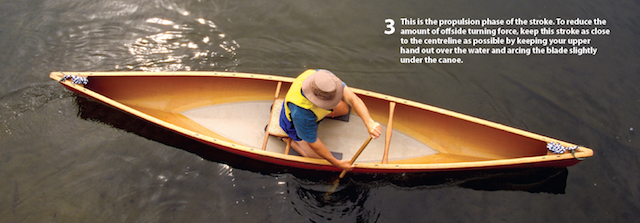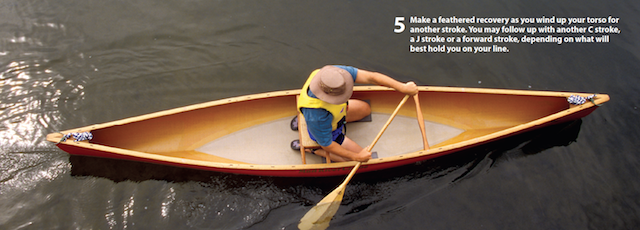The canoe C stroke is a good start-up stroke for soloists to get their craft moving forward in a straight line. It’s so-named because it’s a combination stoke in which a bow draw, forward stroke and J stroke come together so the path the canoe paddle travels resembles the letter C.
The bow draw and J stroke portions of the stroke keep the canoe from veering to the offside in response to the turning force of the forward stroke. Even after the canoe is moving forward the C stroke can be useful when you want to forcefully turn the canoe in an onside direction.
Steps to complete the canoe C stroke
1. Start your stroke
Wind up your torso by rotating your upper body to the offside. Plant the blade further away from the hull than you would for a forward stroke. Angle the power face toward the hull. The thumb on your upper hand should be pointing toward the stern.

2. Top of the C
Scribe the top hook of the C by drawing the bow of the canoe to the blade. Your upper hand should pass over-top the gunwales and be out over the water, with the thumb still pointing toward the stern.

3. Forward stroke
This is the propulsion phase of the stroke. To reduce the amount of offside turning force, keep this stroke as close to the center line as possible by keeping your upper hand out over the water and arching the blade slightly under the canoe.

4. Bottom of the C
At the end of the forward stroke, turn your control thumb forward to complete the lower hook of the C. This is really the J pry of the J stroke. Roll your wrists forward and use the gunwale or your shaft hand as the fulcrum while you apply outward force to the power face.

5. Back to the start
Make a feathered recovery as you wind up your torso for another stroke. You may follow up with another C stroke, a J stroke or a forward stroke, depending on what will best hold you on your line.

[ Plan your next canoe adventure with the Paddling Trip Guide ]



